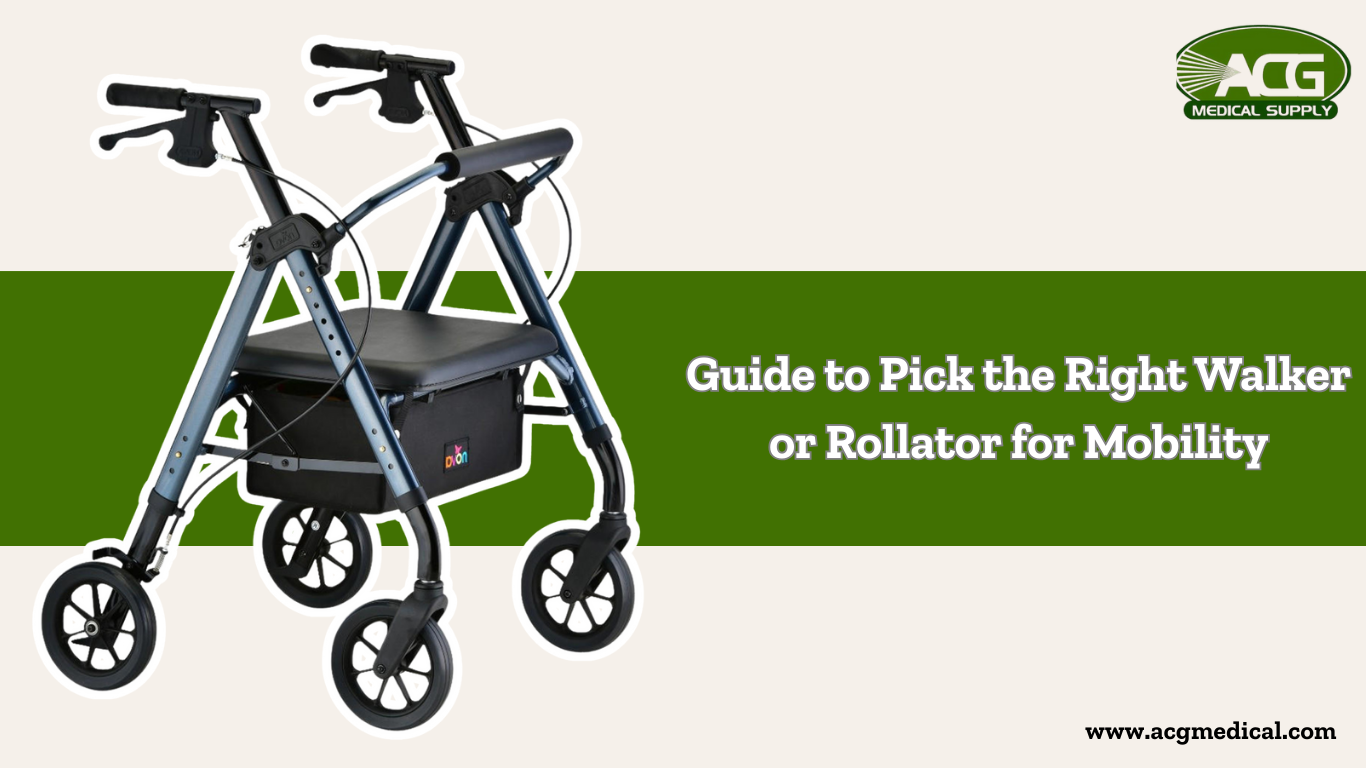Nobody wakes up on a Tuesday morning excited to buy a walker. It’s usually something you put off until a doctor insists, or worse, after a fall scares you into it.
Because of that hesitation, most people rush the process. They type “walker” into a search bar, buy the first thing that looks decent, and end up with a piece of metal that sits in the garage because it’s too heavy to lift or gets stuck on the living room rug.
If you’re going to spend the money, get the tool that actually fits your life. There is a massive difference between the standard grey frame you see in hospitals and the newer mobility aids that actually handle sidewalks and grocery stores.
Here is how to figure out what you actually need before you browse ACG Medical Supply for a Walker Rollator.
The Walker vs Rollator Distinction
People mix these up constantly. If you want to buy a rollator walker, you need to know the difference, because they serve two opposite functions.
1. The Standard Walker (The Frame) This has no wheels (or maybe two small ones on the front) and four rubber feet. It is a stability anchor. You lift it, move it forward, and step into it.
- Who it’s for: People who cannot bear full weight on a leg (post-surgery) or who have severe balance issues where they might fall backward.
- The reality: It is slow. It is laborious. But it is safe.
2. The Rollator (The Cruiser) This is the Walker Rollator. It has wheels on all legs, hand brakes, and usually a seat. You don’t lift it; you push it.
- Who it’s for: People who can walk but lack endurance. If you get winded walking to the mailbox or feel a bit unsteady on uneven pavement, this is your gear.
- The reality: A walker rollator is faster and easier, but it requires you to have enough control to squeeze the brakes.
Don’t Ignore the Hardware
When you look at a rollator walker for sale, don’t look at the color. Look at the tires and the weight. These are the two things that will annoy you the most if you get them wrong.
The Wheel Situation
Standard 6-inch wheels are fine for smooth linoleum. That’s about it. But the second you step outside? Nope. Sidewalk cracks, parking lots, elevator gaps, thick carpets – small wheels lose their mind at all of these. If you even think about leaving your house, go for 8-inch wheels or bigger. A four-wheel rollator walker with larger tires glides over bumps instead of jabbing your wrists every five seconds. It’s the main difference between “it was a nice walk” and “why does my wrist hurt already?”
The Trunk Test(Portability)
Heavy-duty rollator walkers are rock solid, which is great… until you actually have to pick one up. Ask yourself the real question: Can I lift this thing into the car without regretting all my life choices?
If you drive, this test is non-negotiable. You should be able to fold it, slide it into the trunk, and not feel like you’ve just done a gym session.
Older rollators usually fold front-to-back, and they stay bulky – like trying to store a metal giraffe. Newer “Euro-style” ones fold side-to-side and stay standing when folded. Way easier to handle, and compact enough to slip behind a restaurant table without causing a scene.
And if you have shoulder issues, prioritize a lightweight rollator walker made of aluminum rather than steel.
The Seat is a Tool, Not a Luxury
A rollator walker with a seat isn’t just for comfort; it’s about range as well. If you know you have a portable chair, you’re more likely to go to the museum or the farmers’ market. You don’t have to scan the room for a bench constantly. But check the seat height. If your feet dangle when you sit, it’s dangerous. If your knees are up by your chin, you’ll never be able to stand back up.
The Best Option Depends on the User
There is no single best rollator walker for seniors. There is only one that fits the specific deficit you are trying to fix.
- The Indoor User: Needs a narrow frame. Bathroom doors are notoriously thin. Measure your narrowest door frame before you buy.
- The Outdoor User: Needs larger wheels and a seat.
- The Larger User: Needs width. Standard walkers can pinch the hips. A bariatric or heavy-duty model isn’t just stronger; it’s wider. ACG Medical walker rollator options usually list the seat width clearly, so pay attention to it.
Quick Spec Comparison
| Feature | Standard Walker | Rollator (3 or 4 Wheels) |
| Primary Function | Weight-bearing support | Balance & Stamina |
| Motion | Stop-and-go | Continuous walking |
| Brakes | None | Hand loops (Essential) |
| Seat | No | Yes (usually) |
| Terrain | Indoors / Flat surfaces | Outdoors / Uneven ground |
| Energy Use | High (lots of lifting) | Low (gliding) |
Accessories You Actually Need
Most rollator accessories are junk, but a few are non-negotiable.
- The Tray/Basket: You need to carry things. If you are using both hands to push the walker, how do you carry a coffee or a book? You don’t. Get a basket.
- Cane Holder: Many people use a rollator for long distances but switch to a cane for tight spaces (like a bathroom). A clip-on holder will keep the cane within easy reach.
- Good Brakes: Rollator walker brakes wear out or get loose. Check them. If you have weak hands, look for “push-down” brakes rather than the bicycle-style squeeze handles.
Where to Look
You can find cheap units at big-box pharmacies, but they often rattle and rust quickly. ACG Medical Supply carries serviceable brands – meaning you can actually buy replacement wheels or brake cables later. That’s important. A walker is a vehicle; it needs maintenance.
Conclusion
The right equipment stops being a medical device and starts being a tool. It stops looking like a symbol of aging and starts looking like the thing that lets you walk your dog again. Don’t buy the first thing you see. Measure your doors, check the wheel size, and be realistic about where you’re going to use it.
FAQ
1. Which is better – a walker or a rollator?
Depends on your stability. Walkers are steadier. Rollators are faster and easier outdoors.
2. What should I look for in the best rollator walker for seniors?
Good brakes, comfortable seat, proper height, easy folding, and steady wheels. And comfort – seriously, seniors shouldn’t compromise on that.
3. Are lightweight rollator walkers safe?
Yes, as long as you’re not relying heavily on them for balance. They’re great for active users.
4. Do I need rollator accessories?
Maybe not needed, but they make life easier. Cup holders, storage, backrests — tiny upgrades, big comfort.
5. What if I’m tall?
Don’t hunch. Look for “Tall” variations. Using a standard height walker when you are 6’2″ will wreck your back in a week.

